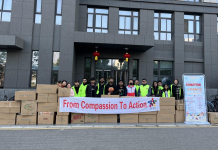HASA: Tibetan herder Tenzin is wrapped in a thick traditional robe, a headscarf and gloves as protection against the chill wind that sweeps across the vast prairie in southwest China’s Xizang Autonomous Region. Even so, she had her nails meticulously done to celebrate the Tibetan New Year.
At the most important festival for Tibetans, which fell on Saturday this year, she and her family cleaned their 50-square-meter clay house, fired up the yak dung stove and prepared barley wine and traditional snacks they bought in the regional capital Lhasa — some 800 km away from home — to serve the visiting guests.
Tenzin, 22, comes from a village in Ngoqu Township, Nyima County, at an altitude of more than 4,700 meters. The village is part of the Changtang National Nature Reserve, China’s biggest and highest nature reserve.
In August 2022, Tenzin and her family were relocated to a new community called Singpori some 10 km from Lhasa airport, as part of a relocation project to offer herders a better living environment and hand over the nature reserve to wildlife. The government has set up a transitional period spanning the next few years, during which some young people will be taking turns at herding on the prairie.
Since then, Tenzin has been traveling between her two homes, enjoying the pleasures of modernity at her new home and herding back at the old one.
As the eldest child in her family, Tenzin is a major breadwinner, but herding in this area is not an easy lifestyle. –Agencies






